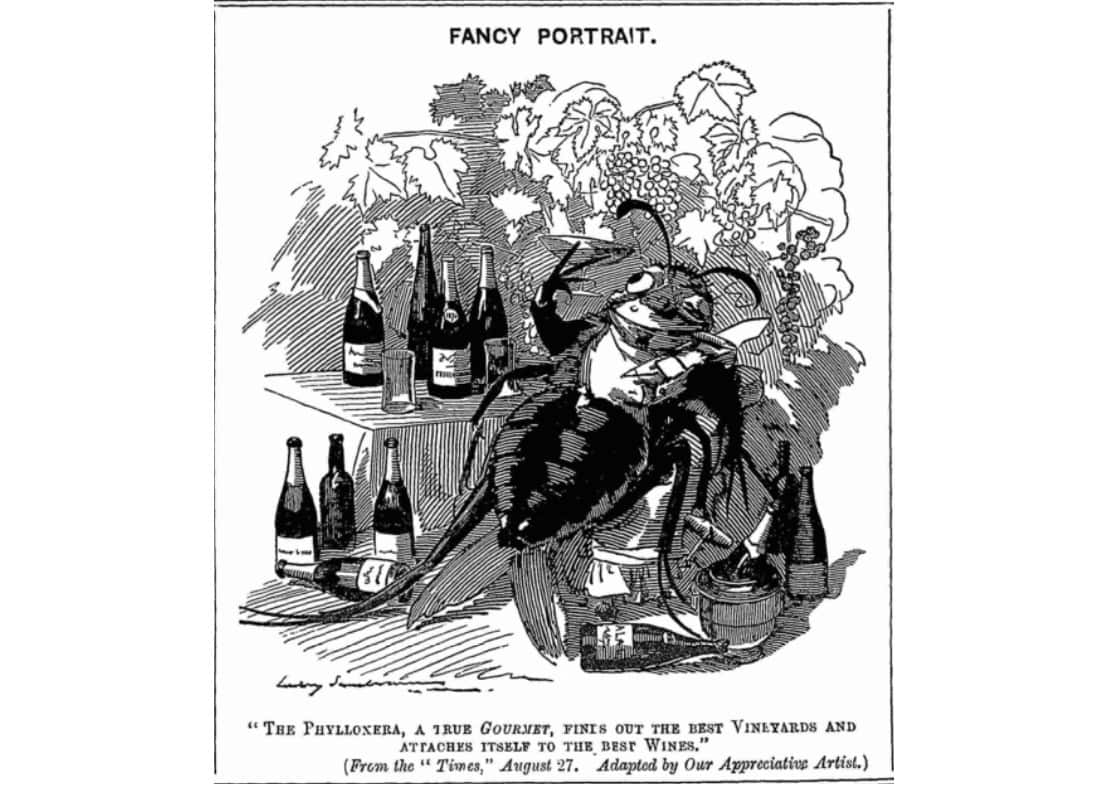│By Amelie Bonney, Gale Ambassador at the University of Oxford│
Have you recently enjoyed a special, vintage bottle of wine to celebrate the New Year with your family or friends? You might be surprised to learn that such celebrations might have been quite dangerous during the nineteenth century. Expecting the crimson-coloured beverage to enrapture their senses and coat their tongue in luscious flavours of dried blackberry, leather and tobacco, wine aficionados were often far from suspecting that this elixir could easily turn out to be a cheap, dyed, falsified drink, or worse – deadly poison. In an age where strict regulations exist to control food and beverage adulteration, such hazardous dyes are no longer used, but delving into Gale’s Historic Newspapers allows us to better understand how such dangerous adulteration was allowed to occur during the nineteenth century.
Gale Primary Sources conveniently allows you to track term frequency across all online archives available at your institution, and demonstrates that adulteration and poisoning became an increasing issue in the aftermath of the industrial revolution. While the upsurge of articles on these topics must also be understood as a direct consequence of the rising production of newspapers during the second half of the nineteenth century, it is certainly also representative of increasing hazards to wine consumers of the time. First obtaining an insight into the practices of European winemakers over the past centuries enables us to better grasp the reasons for increasingly widespread wine adulteration throughout the nineteenth century.

Wine adulteration: a long-lived and lucrative business
Wine adulteration had been an issue long before the nineteenth century, as exemplified by several sources that can be accessed thanks to Gale’s Eighteenth Century Collections Online. In early eighteenth-century London, wine merchants drafted a series of proposals to the House of Commons, which was one of several attempts made to better regulate their trade and prevent the circulation of adulterated goods.
![The wine merchants proposals, for preventing sophisticating and vitiating wines, &c. Humbly offer'd to the Honourable House of Commons. N.p., [1704?]. Eighteenth Century Collections Online,](https://review.gale.com/wp-content/uploads/2020/01/Amelie-adulteration-blog-the-wine-merchants-proposals.png)
https://link.gale.com/apps/doc/CW0107401476/GDCS?u=oxford&sid=GDCS&xid=b4cc8e43
In these proposals to the House of Commons, they insisted on the need to take an Oath before the Justice of Peace to prevent the sale of damaged wines. While some practices, such as the addition of egg whites, were considered absolutely necessary for the process of wine production, the addition of “sophisticating ingredients” such as English sweets, syrup and cider was undesirable as they substantially altered the taste and quality of a wine. In this context, in 1795, the medical man John Wright published an essay intending to instruct his readers on adulteration, as well as on the useful or injurious effects of these beverages on human health. As his inquiries on port wines demonstrated, adulteration was a highly lucrative business, allowing merchants to sell poor quality wine at the same price as outstanding bottles.
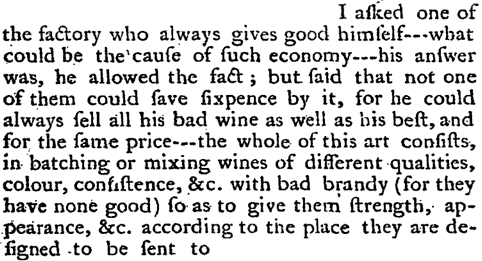
https://link.gale.com/apps/doc/CW0124912908/GDCS?u=oxford&sid=GDCS&xid=7e987810
Wine adulteration continued to be a widely debated issue in the nineteenth century. In 1857, an article from the Morning Post included in Gale’s British Library Newspapers archive reported that not even the wines used in religious ceremonies were exempt from it. Reverend John Purchase’s complaint that “even the sacramental cup was not exempt from adulteration” prompted him to request a chemical analysis of a wine sample. Arthur D. Eck, the Cambridge chemist whom he consulted, found that the Reverend’s wine was indeed a compound of “treacle, spirits of wine, water, and a small quantity of genuine but very sour wine”, a case which was far from uncommon at the time.

https://link.gale.com/apps/doc/R3212062492/GDCS?u=oxford&sid=GDCS&xid=f00ad685
From one poison to the next: the wine trade after the Phylloxera epidemic
Wine adulteration drastically increased during the second half of the nineteenth century in response to a severe crisis affecting the wine industry. From 1863, French vines in the southern Rhône region started to be afflicted by a mysterious disease which quickly spread to the rest of the European continent, destroying a large proportion of vines in the process and inducing a wine shortage. Phylloxera, an insect from North America, was the cause of this plight which soon also decimated some of the best Hungarian vines of Tokaj, a crisis covered in the Times newspaper and now accessible through The Times Digital Archive.
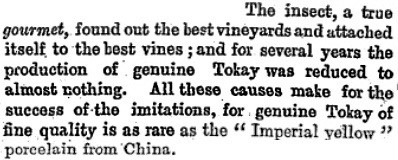
https://link.gale.com/apps/doc/CS118018843/GDCS?u=oxford&sid=GDCS&xid=cc6aaf1f
The economic impact of the phylloxera epidemic was soon to be felt and was widely reported on in Europe but also in the United States. Gale’s Nineteenth Century U.S. Newspapers gives us access to an 1890 article published by the Chicago-based newspaper Daily Inter Ocean, whichreported on the great losses this epidemic caused for the French wine industry. Whilst the country produced “nearly a thousand million gallons” prior to the epidemic, its production had decreased to 546,000,000 gallons in 1887, according to the author’s sources.
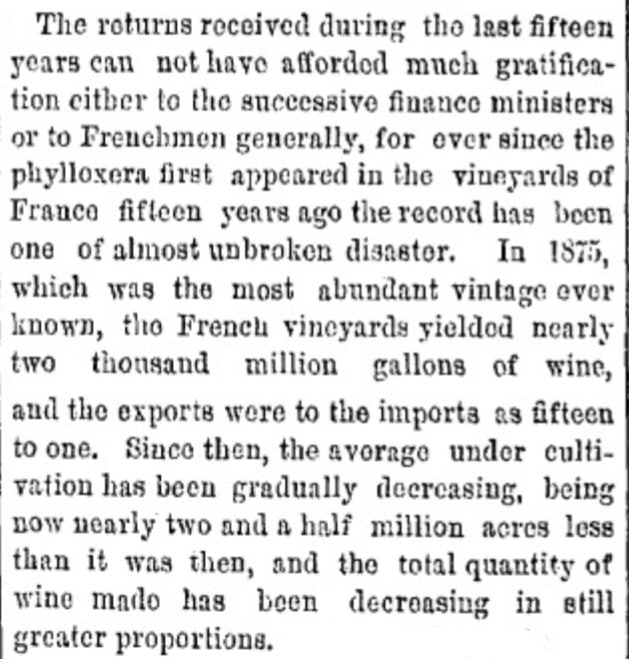
Poisoning Cases: Aniline, Fuchsine, and Arsenic
Consequently, ruined winemakers had to import foreign wines to blend them with French wines or produce artificial wines. Many attempts to imitate wine and to create wine-alternatives developed to make up for the lost wine. In this process, aniline dyes such as fuchsine or magenta were increasingly used as additives to improve a wine’s colour, a practice which winemakers continued to resort to even after the wine industry had recovered.
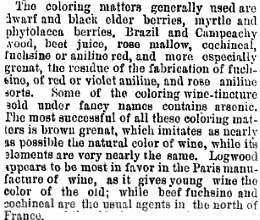
https://link.gale.com/apps/doc/GT3001407688/GDCS?u=oxford&sid=GDCS&xid=f6000cb5
The addition of these colours was however quite dangerous, as the poisonous substance arsenic was used in their production process. This toxic substance was cheaply available and used as a rat poison as well as a weed killer, while also being a part of the production process of the newly invented aniline dyes. Arsenic was repeatedly connected with criminal poisoning cases, and it is therefore not surprising that its use in the adulteration of wines caused similar accidents, such as the poisoning of an entire village in the area of Bordeaux in 1889.
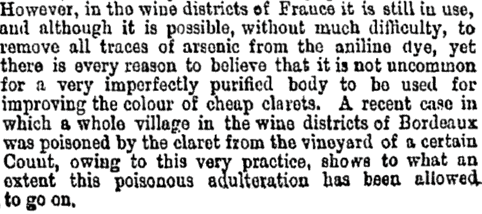
The Science of Detection and Prevention?
Methods to detect adulterated foodstuffs were soon propagated in the press to enable customers to use simple methods to determine whether or not their wines were safe to drink.
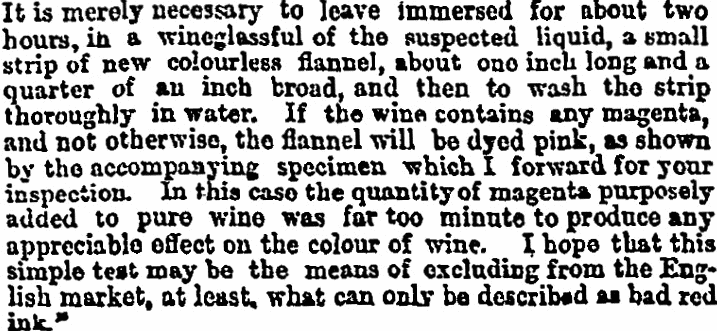
By 1895, advertisements were also circulated in the press to warn readers of the dangers of adulteration, promoting greater caution when purchasing goods. Advertisements such as the one below, which can be accessed through the Illustrated London News Historical Archive, also partly responded to growing consumer activism, which emerged at the turn of the nineteenth century in the wake of numerous public health scandals involving adulteration cases. However, in many ways warnings against the dangers of aniline dyes were just another marketing technique aiming to sell supposedly safer products, such as this advertisement for “Eno’s Fruit Salt”
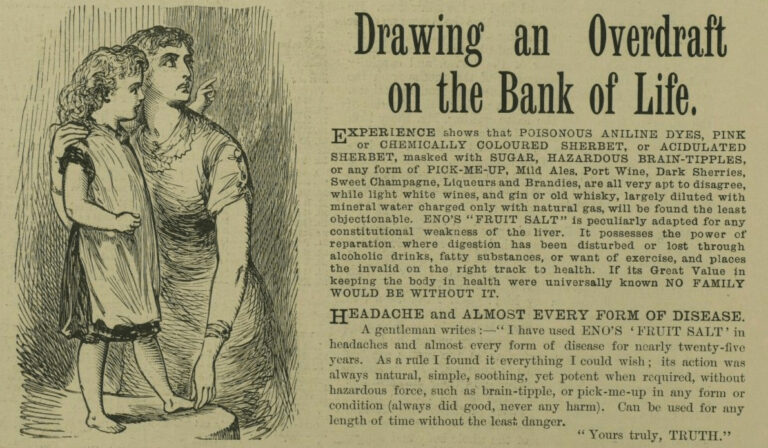
https://link.gale.com/apps/doc/HN3100148512/GDCS?u=oxford&sid=GDCS&xid=3c07f641
Despite further awareness of wine adulteration and growing fears of its impact on the overall health of the population, the practice continued nonetheless, as testified by the case of Patrick McCluskey, who was tried in 1919 for selling adulterated port:
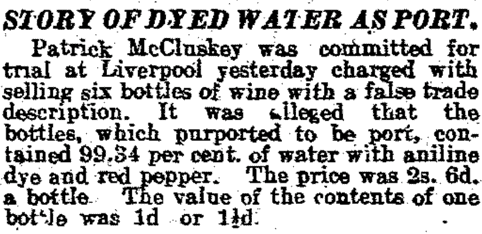
While the addition of fuchsine, aniline or arsenic to wines now seems to be a hazard of the past, the chemical industry continues to have a strong influence in wine production, and phylloxera has profoundly changed the wine industry, affecting almost the entirety of the globe apart from Chile, South Australia and some parcels of land in Europe, which now produce highly coveted wines.
If you wish to learn more about the history of toxic colours in wines, or if you are an Oxford student or researcher wanting to learn more about ways in which you can use Gale Primary Sources for your own research, feel free to contact me via Twitter (@BonneyAmelie).
Blog post cover image citation: ““The Phylloxera, a true gourmet, finds out the best vinyards and attaches itself to the best wines.” (From the “Times,” August 27. Adapted by our Appreciated Artist.)” Sambourne, Linley. “Fancy Portrait.” Punch, 6 Sept. 1890, p. 110. Punch Historical Archive, 1841-1992, https://link.gale.com/apps/doc/ES700268839/GDCS?u=webdemo&sid=GDCS&xid=7c95d71e

